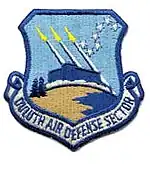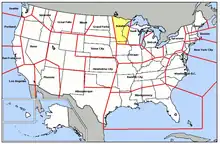Duluth Air Defense Sector
The Duluth Air Defense Sector (DUADS) is an inactive United States Air Force organization. Its last assignment was with the Air Defense Command 29th Air Division, being stationed at Duluth Airport, Minnesota. It was inactivated on 1 April 1969.
| Duluth Air Defense Sector | |
|---|---|
 Emblem of the Duluth Air Defense Sector | |
| Active | 1959–1966 |
| Country | United States |
| Branch | United States Air Force |
| Role | Air defense |
| Part of | |
| Garrison/HQ | Duluth Airport |

History
Established in October 1957 assuming control of former ADC Central Air Defense Force units with a mission to provide air defense of most of Minnesota and western Wisconsin. The organization provided command and control over several aircraft and radar squadrons.
In November 1959, the new Semi Automatic Ground Environment (SAGE) Direction Center (DC-10) became operational. 46°50′10″N 092°12′26″W DC-10 was equipped with dual AN/FSQ-7 Computers. The day-to-day operations of the command was to train and maintain tactical flying units flying jet interceptor aircraft (F-94 Starfire; F-102 Delta Dagger; F-106 Delta Dart) in a state of readiness with training missions and series of exercises with SAC and other units simulating interceptions of incoming enemy aircraft.
In October 1962, during the Cuban Missile Crisis, a guard at the Direction Center mistakenly identified a bear trying to climb the security fence as a saboteur and rang the alarm, which automatically triggered similar alarms at other bases in the region. A faulty alarm system at Volk Field in Wisconsin led to nuclear-armed interceptor aircraft nearly being launched.[1]
Inactivated April 1966 as part of ADC reorganization and consolidation, the command being redesignated as the 29th Air Division. The SAGE building was remodeled and, in 1985, given to the University of Minnesota Duluth to house the Natural Resources Research Institute signed into legislation to address the struggling economy during the early 1980s recession.
Lineage
- Established as Duluth Air Defense Sector on 1 October 1957, Inactivated on 1 April 1966
Assignments
- 37th Air Division, 1 October 1957
- 31st Air Division, 20 December 1957
- 37th Air Division, 1 January 1959
- 30th Air Division, 1 April 1959 – 1 April 1966
Stations
- Duluth Airport, Minnesota, 1 October 1957 – 1 April 1966
Wings
- 56th Fighter Wing (Air Defense): K. I. Sawyer AFB, Michigan, 1 October 1963-1 January 1964
- 507th Fighter Wing (Air Defense): Kincheloe AFB, Michigan, 1 October 1963-1 April 1966
Group
- 343d Fighter Group (Air Defense): Duluth Airport, Minnesota, 15 November 1959-1 April 1966
Interceptor squadrons
- 18th Fighter-Interceptor Squadron: Grand Forks AFB, North Dakota, 4 September 1963-1 April 1966
- 62d Fighter-Interceptor Squadron: K. I. Sawyer AFB, Michigan, 16 December 1963-1 April 1966
Missile squadrons
- 37th Air Defense Missile Squadron (BOMARC): Kincheloe AFB, Michigan, 1 October 1963-1 April 1966
- 74th Air Defense Missile Squadron (BOMARC): Duluth AF Missile Site, Minnesota, 1 April 1960-1 April 1966
Radar squadrons
|
|
See also
References
| External image | |
|---|---|
![]() This article incorporates public domain material from the Air Force Historical Research Agency.
This article incorporates public domain material from the Air Force Historical Research Agency.
- Sagan, Scott D. (1993). The Limits of Safety: Organizations, Accidents, and Nuclear Weapons. Princeton University Press. pp. 3, 99–100. ISBN 978-0-691-21306-4.
- A Handbook of Aerospace Defense Organization 1946 - 1980, by Lloyd H. Cornett and Mildred W. Johnson, Office of History, Aerospace Defense Center, Peterson Air Force Base, Colorado
- Winkler, David F. (1997), Searching the skies: the legacy of the United States Cold War defense radar program. Prepared for United States Air Force Headquarters Air Combat Command.
- Maurer, Maurer (1983). Air Force Combat Units Of World War II. Maxwell AFB, Alabama: Office of Air Force History. ISBN 0-89201-092-4.
- Ravenstein, Charles A. (1984). Air Force Combat Wings Lineage and Honors Histories 1947–1977. Maxwell AFB, Alabama: Office of Air Force History. ISBN 0-912799-12-9.
- Radomes.org Duluth Air Defense Sector
